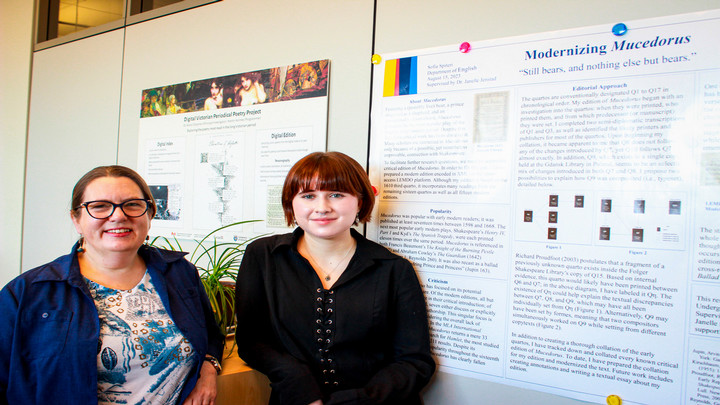Bringing the past to life with digital humanities
January 16, 2024

This fall, in a classroom in the Clearihue building, students in ENSH 352: Renaissance Drama gathered in groups and stage scenes from Mucedorus, an early modern comedy featuring a bear, a prince disguised as a shepherd, and a clown. Over four hundred years separate the play’s first performance in 1590 from these students’ projects. Yet as they performed selected scenes, they found themselves laughing, encountering the humour in the Renaissance comedy.
One of these students was second-year history major Sofia Spiteri, who had just spent four months researching, collating, and editing the modern edition of Mucedorus that the class used for their performances. Now, the text that Sofia edited is a classroom tool being used by their peers to study early modern performance.
Opportunities for student research
As a first-year student in HUMA 180: Examining Humanities Research, Sofia completed an internship working on the Map of Early Modern London (MoEML) with Janelle Jenstad, a professor in the Department of English whose work in digital humanities and early modern drama has included projects like the MoEML and Linked Early Modern Drama Online (LEMDO). Jenstad suggested that Sofia apply for a Valerie Kuhne Undergraduate Research Award (VKURA), which funds a 12-week, full-time research internship for first- and second-year undergraduate students. The two of them would work together on Mucedorus, editing the play for LEMDO’s Digital Renaissance Editions.
“I think it’s great that the internship is targeted at first- and second-year students. Getting involved in research early in your degree can show you what you like and don’t like,” Sofia shares. As a faculty member, Jenstad sees opportunities like the VKURA as transformative for both faculty supervisors and student researchers. For Sofia, the practical experience of researching and editing a text helped her envision how her interests could translate into a career as an editor.
Early modern sleuthing
Sofia’s edition of Mucedorus began with an investigation into its print history, a process that led to significant archival detective work as they tracked down all seventeen extant versions of the text (quartos). “I wanted to track down all the printers of all the different versions of Mucedorus, because I wanted to see where this play had gone throughout its life.” Mucedorus was, according to Jenstad, the most-printed play of the period, with seventeen editions printed over a nearly ninety-year period, so this was no small feat.
The most exciting moment in this process was tracking down a 1621 edition of the play that now exists in only a single copy, which had last been seen in a library in in what was then known as Danzig, Germany (modern Gdańsk, Poland) in 1939. After hours of research, Sofia suspected that the edition might be held at Gdańsk Library, so they did what any enterprising young researcher would: she used translation software to put together an email in Polish and ask.
Sofia’s excitement as they recount the story is palpable—the edition was, indeed, at Gdańsk Library, and they offered to prepare scans for her use. She became the first modern scholar to transcribe the 1621 edition of the play.
Technology driving accessibility
When Sofia first encountered Mucedorus, one of the most popular comedies of the early modern period, they were baffled by how little critical work had been done on the play. Although it was one of the most popular plays of its time, it’s now difficult to access, making it a challenge to teach and study. To Sofia, developing an open-access modern edition of Mucedorus was important because it allows researchers to work on the play, which she and Jenstad consider crucial to understanding early modern culture and book history. LEMDO was the perfect tool for the job.
“LEMDO is all about recuperating early modern plays that aren’t teachable or performable because there are no available texts for them,” Jenstad explains. In part, this is a response to the decrease in the number of early modern plays that are accessible for students, scholars and performers. “Using the technology that we’ve built here, we can create a free, open-access digital edition.”
Prioritizing accessibility means that plays published through LEMDO are available in a range of formats, including an online version, a downloadable file, and a print-on-demand book. The goal is to make plays like Mucedorus useable for students with a wide range of learning styles with as few barriers as possible.
As a result of Sofia’s research, LEMDO has created a tool called LEMDO Classroom, which can house unfinished editions, like Sofia’s. LEMDO Classroom allows people to teach from incomplete editions, expanding access to hard-to-find texts and allowing editors to learn from the experience of using a play in the classroom.
“Students ultimately get to have a shaping role in the text that is ultimately designed for students,” Jenstad explains. “We can use performance and classroom practice to make the edition better.” When she prepared to teach Mucedorus in Renaissance Drama, she knew that she would teach from Sofia’s edition.
Working with other students to stage a scene from the play, Sofia experienced the story in an entirely new way.
“It was so amazing seeing Mucedorus being performed in front of me,” Sofia recalls. “I had spent the entire summer trying to imagine this in my head. That was all I could ever do. There was no performance that I could watch.”
Her work on the play isn’t done—she has plans to continue annotating the text and to write a textual essay to introduce the edition—but thanks to Sofia’s research, and the tools offered by LEMDO, Mucedorus has already begun to come to life for students and researchers.
